History repeating: Georgian Ireland’s property bubble
Published in 18th-19th Century Social Perspectives, 18th–19th - Century History, Features, Issue 1(Jan/Feb 2012), Volume 20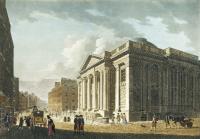
The Royal Exchange (now City Hall), built in the 1770s facing Parliament Street (off picture, to the left), the first street to be laid out by the Wide Streets Commission, the earliest modern urban planning authority in Europe. (National Library of Ireland)
With an estimated four million people by the 1770s, Ireland had undergone a population explosion that made Dublin the second-largest city, after London, in the British Empire. Nevertheless, despite this growth, in terms of infrastructure Ireland’s capital city remained a small, densely populated, essentially medieval city, akin to contemporary Paris. Just as would happen in Haussmann’s Paris during the nineteenth century, however, Dublin during the Georgian period, like many of Ireland’s other urban centres, was to undergo major redevelopment, as the newly established Wide Streets Commission did away with many of the dank and narrow medieval laneways of the old city, replacing them with wide and salubrious Georgian boulevards.
Wide Streets Commission
The Wide Streets Commission, the first modern urban planning authority in Europe, was established to solve the capital’s increasing congestion problems. Beginning with the redevelopment of Dame Street and its surrounds, the commissioners were also responsible for much of the quays, the Liberties and the area around the new Custom House. Downriver, the improvement of the city’s docklands—the most capital-intensive project yet undertaken in Ireland—was about to make Dublin one of the largest contemporary ports in the world. With Ireland’s capital formation continuing apace, a huge network of halfpenny and penny turnpike (toll) roads were added to connect the country’s urban centres, as the national economy became increasingly export-driven.Throughout the country prosperity began to appear the norm. House rents doubled nationally from about 1780 onwards, and in some areas they even quadrupled. New houses were built in every direction, as builders used literally every spare piece of land to make a profit. One contemporary reported that Lowrey’s Court off Mountjoy Square consisted of three houses ‘built upon a space not large enough for one’. Herd behaviour is typical of economic bubbles, and the massive housing demand amongst Ireland’s eighteenth-century inhabitants was no exception.
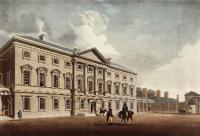
Several of the country’s finest mansions—including the duke of Leinster’s
Speculative attraction
A bubble is defined as a sharp rise in the price of an asset or assets, the initial rise generating expectations of further rises and attracting new buyers—generally speculators interested in profits from trading in the asset rather than its use. The movement into property speculation by many leading banks, aiming to capitalise on the investment attractions of developing property at a time when interest rates were unusually low and demand for housing was rising, further inflated property prices.To be successful, however, any planned residential area in the eighteenth century needed to be associated with fashionable society. Enjoying close ties with bankers and politicians, property speculators in Georgian Ireland were very successful at attracting the necessary ‘quality’ of resident. One method was through land rezoning. Like Joshua Dawson before him, Luke Gardiner, for example, as MP for County Dublin, used his political connections to create a new Dublin parish, St Thomas’s. By getting the parish rezoned, Gardiner ensured that residents would have greater control over parish utilities and taxes, thus guaranteeing protection of the financial interests of wealthy inhabitants.Connections were crucial. At various times, several members of the la Touche banking family, for example, sat on the board of the Wide Streets Commission (one member, David Digges la Touche, was simultaneously governor of the family bank, chairman of the Wide Streets Commission and an MP)—no conflict of interest being perceived between their roles as financial lenders to the commission while influential members of its board. Little wonder that, with the growing profitability of property, Irish banks gradually turned from their traditional mercantile priorities, instead channelling profits in the direction from which they were primarily being generated: property speculation.
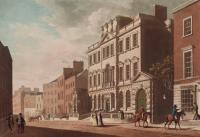
Lord Powerscourt’s townhouses—were put up for sale, and many of its once-elegant Georgian neighbourhoods were transformed into slums, as the city fell into a depression from which it would not begin to recover for over 150 years. (National Library of Ireland)
Easy money
A bubble’s first phase is typically a boom or growth period. What helps to turn it into a bubble is usually the supply of easy money, in the form of expansionary monetary policy, lax credit standards and direct lending to speculators. In this way cheap money and easy credit are the monetary equivalent of throwing petrol on a fire. In the case of Ireland’s first property bubble, lax credit standards and easy money were provided by the movement of several leading lenders into property speculation at a time when the national money supply was being vastly expanded. In an era of unregulated banking, the Bank of Ireland alone (whose board of directors included several private bankers and prominent property developers) multiplied its money issue by almost 360% in just ten years. A measure of Ireland’s new-found prosperity, most of the country’s finest Georgian buildings are legacies of this boom: Dublin’s iconic Parliament House, the Custom House in Cork and Limerick’s Mallow Street. All testify to the ‘irrational exuberance’ for speculative development. Such expenditure had to be financed, and at the heart of Ireland’s eighteenth-century property bubble lay reckless lending. Banks became large-scale mortgagers, lending to buy property, with those very properties used as collateral. Like the notorious lending practices of recent times, the innovations that banks developed to encourage spending, such as supplying customers with discounts and blank cheques to draw on the bank at will, helped to fuel the bubble to even dizzier heights.The boom looked never-ending. That was why so many were attracted to property as a seemingly risk-free investment. With hindsight it is obvious that this façade of prosperity concealed dangerous weaknesses. Unfortunately for Georgian Ireland, few could foresee the looming catastrophe. On the eve of the Act of Union most people were still optimistic about Ireland’s economic prospects. It would not take long to expose the underlying fragility of the country’s recent economic success.
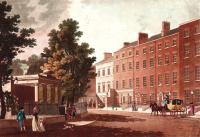
Charlemont House (now Dublin City Gallery: The Hugh Lane) in Rutland (now Parnell) Square—by the time of the Great Famine houses off Mountjoy and Rutland Squares, by now the poorest district in the country, were valued at less than £5 each.
The bubble bursts
When the Irish parliament was disbanded following the Rebellion of 1798, the country’s economy fell into recession. With no parliamentary duties to compel their presence, many of the leading gentry relocated to London. The wealthier classes were now living primarily outside of Ireland and the resultant decline in expenditure gave rise to serious financial problems at home. Several of the country’s finest mansions—including the duke of Leinster’s and Lord Powerscourt’s townhouses—were put up for sale, and many of its once-elegant Georgian neighbourhoods were transformed into slums, as the city fell into a depression from which it would not begin to recover for over 150 years.With the gentry departed, the country’s services sector all but disappeared. Whitelaw’s 1798 census, for example, counted the preponderance of servants as 10.6% of the total population of the city. Post-Union the figure was a mere fraction. This capital flight, along with the overwhelming tax burden placed on Irish citizens since the outbreak of the French revolutionary wars, contributed to a seizing up of liquidity. The enormous cost of compensation—estimated to total £12 million (€438m in today’s money)—paid to the politicians and civil servants whom the Union had deprived of their jobs exacerbated the problem, so that by the time the Union took place Ireland was suffering a severe debt overhang. Irish national debt had leaped a colossal 1,400% between 1793 and 1802. A myriad of taxes were introduced but it was still impossible to meet expenditure out of revenue. State borrowing only aggravated matters by increasing the interest due on government loans.With the seizing up of capital liquidity, demand for housing collapsed and little further development was undertaken before many of the developers went bust. More ominously, vast swathes of Limerick, Cork and Dublin cities became characterised by tenements, as many of the once-elegant Georgian structures were reduced to slums. Simply put, just as the demise of the global banking system brought an abrupt end to the extravagant Celtic Tiger era, the war debts of the nineteenth century resulted in an inevitable and swift contraction of public and private spending and an abrupt bursting of Ireland’s Georgian property bubble.
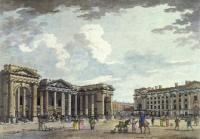
Perhaps most symbolic of the crash was the Parliament House. Built in 1729 for a sum of £40,000, the building was extended in 1785, 1794 and 1797, respectively, at an aggregate cost of a further £55,000. In 1802, however, just five years after the last extension was completed, the entire complex was sold off in a government fire-sale to the Bank of Ireland for a mere £40,000—£15,000 less than the cost of the extensions alone. (National Library of Ireland)
Free-fall
Pre-Union, an acre of Dublin land typically fetched more than three times its London equivalent. By 1820, however, its value had halved. In some areas the decline was even sharper. Whereas Merrion Square mansions were selling for up to £8,000 each in the 1790s, by 1801 their price had plummeted to only £2,500. By the time of the Great Famine the same properties were available for less than £500. Houses off Mountjoy and Rutland (now Parnell) Squares, by now the poorest district in the country, were valued at less than £5 each. Others there and on St Stephen’s Green were simply abandoned, while many never even found a buyer in the first place. So bad was the decline that an Encumbered Estates Court—the contemporary equivalent of NAMA—was established to deal with the mess. Truly, those who cannot remember the past are condemned to repeat it. HI
Séamus Nevin recently completed a master’s degree on Ireland’s Georgian property bubble at the London School of Economics.
Further reading:
D.A. Chart, Ireland from the Union to Catholic Emancipation: a study of social, economic and administrative conditions 1800–1829 (London, 1910).M. Craig, Dublin 1660–1860: a social and architectural history (Dublin, 1969).F.G. Hall, The Bank of Ireland 1783–1946 (London, 1948).C. Maxwell, Dublin under the Georges, 1714–1830 (Dublin, 1997).
















